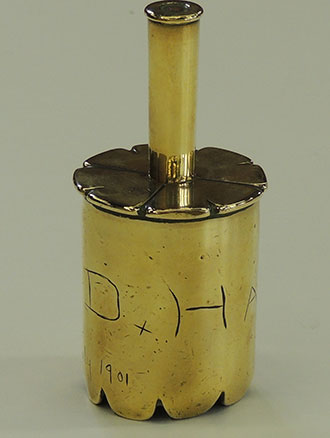July
A hundred years of memories: the North East’s art of war

The stories behind unique artefacts made by soldiers in the trenches of the First World War are being brought together for the first time.
Researchers at Newcastle University are working with Beamish Museum to compile the history of dozens of pieces of trench art – decorative items made from materials originally used in the waging of war such as artillery shells and bullet casings.
Although there are examples of trench art being created as far back as the Napoleonic Wars right through to the present day, it is more commonly associated with the First World War as this was the first industrialised conflict, waged on a massive scale.
As a result, there was an increase in the amount of war-related debris and materials available. These were then turned into decorative objects such as vases and rings, or items with a specific purpose such as clocks, cigarette lighters and matchbox holders, using whatever was to hand. Many pieces show a high degree of skill – a reminder that those serving would have included engineers, miners, mechanics, and farriers among others, who took these skills with them to the Front.
Now, in the lead up to the centenary of the 1918 armistice, the researchers want to know more about these items, the men who created them and the stories of what happened to them after the war, when many pieces of trench art were brought back from the front line and into homes across the region.
The research is being carried out by Andrew Marriott, from the School of History, Classics and Archaeology. A former soldier, and now archaeologist, Andrew explains: “While the original makers and owners have passed away, the centenary of the First World War presents an excellent opportunity to research how trench art provides a means of commemorating the war and remembering its participants.
“We want to find out how much trench art exists in the North East, especially items that have a family story to tell. We want to know what happened to these items when the war was over. Were they proudly displayed in the home or kept hidden away, a painful reminder of what had happened? And in the decades after the war, what did younger generations feel about them – particularly in the fifties and sixties, when attitudes towards warfare were changing?
“If only these objects could talk, I’m sure we’d hear some fascinating tales connected to how they were made and what happened to them when the Great War ended. This project will tell us much about these unique art forms and the social history not just of the war, but of the 100 years since. It will also allow us to access generations of memories before they’re lost forever.”
A lot of trench art was made by soldiers as a way to pass the time, but sometimes as souvenirs or tokens of affection or remembrance to be sent back home. Other pieces may have been a statement of self-expression in a highly regimented environment, possibly even an act of subversion, since for the first two years of the war it was illegal to keep used artillery shells, as most of them would be re-packed with explosives and sent back to the front line to be re-used.
There were also examples of trench art being made by injured soldiers as they recuperated in hospital. These would then be sold to raise funds for those affected by the fighting.
The information gathered will be used to create an online database of trench art in the North East. Staff at Beamish Museum also plan to create a trench art exhibition, which will go on tour around schools and community groups in the region. Beamish is hoping to include a number of these pieces in the 1950s developments at the Museum so that their stories can be shared with future generations.
Kate Reeder, Head of Social History and Collections Management at Beamish Museum, said: “We are very excited about being involved with this project. The stories behind the pieces brings to life what can be a period of history full of facts and figures, as you learn about the reality of war. It is a privilege to be able to capture this information and share the history of the north east with the world.”
More information about the Trench Art project can be found on the Beamish Museum website. Anyone who owns trench art that is associated with the current or historic counties of Durham and Northumberland and would like to have it recorded as part of this project, should email trenchart@ncl.ac.uk
Pictured: Table bell owned by Field Marshal Douglas Haig. This was made from a rifle shell case and pom-pom shell case.
published on: 8 July 2015
